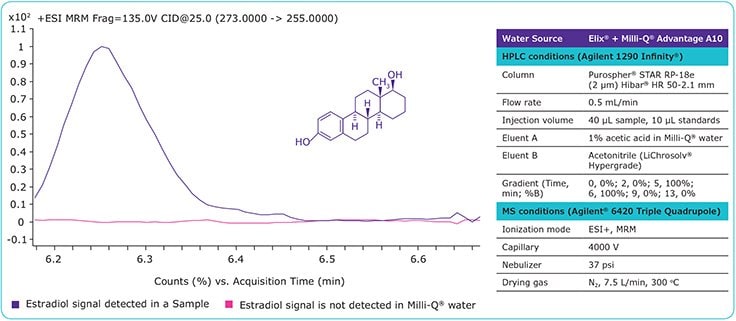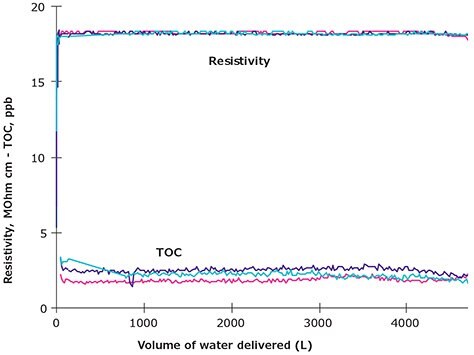Ultrapure Water for LC-MS Biomedical Analyses
Anastasia Domanov1, Matias Kopperi2, Jevgeni Parshintsev2, Stephane Mabic1
1Merck, Lab Water, Saint-Quentin-en-Yvelines, France, 2University of Helsinki, Faculty of Science, Department of Chemistry, Laboratory of Analytical Chemistry, Finland
Abstract
In this paper the suitability of reagent water for LC-MS biomedical analyses will be evaluated and the role of water quality in achieving sensitive and reliable LC-MS analyses will be discussed. Furthermore, since quality assurance is one of the key requirements in the clinical laboratory, a modern solution for data management will be introduced in order to address this need.
Introduction
The power of LC-MS is recognized by biomedical laboratories worldwide.1,2 Nowadays modern LC–MS instrumentation ranges from research to routine use in clinical laboratories and is effectively applied in such areas as:
- Therapeutic drug monitoring – measure of drugs (e.g., immunosuppressants) in plasma, blood or tissues
- Drugs of abuse testing – measure of drugs (e.g., cannabis, methadone, amphetamine, morphine, meperidine, etc.) in urine or saliva
- Hormone testing – measure of hormones (e.g., steroids or thyroid hormones) in serum or plasma
- Biogenic amine analysis – measure of biogenic amines (e.g., catecholamines) in plasma or urine
- Neonatal screening – detection of treatable disorders in infants by monitoring amino acid and acylcarnitine levels using LC-MS
The reason for the considerable attractiveness of LC-MS instrumentation over other analytical tools resides in the technique's ability to measure multiple complex analytes simultaneously with a very high level of sensitivity. Furthermore, speed and confidence are critical pillars in patient care, and successful LC-MS biomedical analysis is a rapid analytical process with a high level of sensitivity, traceability and reliability. Therefore, the suitability of reagent water for the biomedical LC-MS workflow and its role in successful LC-MS analytical practice will be examined through these three major requirements.

Figure 1. The role of water in the LC-MS laboratory
Sensitivity
Ultrapure water is used extensively in the LC-MS workflow (Figure 1) and thus can become a main source of contamination resulting in ghost peaks, noisy baselines and high MS background. These, in turn, lead to poor instrument or method sensitivity and make it challenging to detect analytes at low concentration.3 Moreover, to avoid interferences, it is essential that the detected analytes come from the samples, and not from the water used in various steps of the experiment.4 Therefore, ultrapure water of very high quality must be used in the experiments and handled carefully to avoid its recontamination.5
One of the areas in ultra trace LC-MS biomedical analysis where water is used in significant volume compared to other mixture components is in the measurement of hormones. Thus Milli-Q® water (18.2 MOhm.cm resistivity, < 5 ppb TOC) used in the analytical LC-MS sensitive workflow was analyzed for estradiol as one example of frequently measured hormones. The result of this experiment is presented in Figure 2, where a MRM (multiple reaction monitoring) chromatogram demonstrates the absence of estradiol in Milli-Q® water. The lack of contamination in the reagent water used in the experimental protocol allowed achievement of a low method detection limit and as a result, successful detection of estradiol in a sample at 265.40 ng/L concentration by standard addition method.
Precursor ion 273 m/z and fragment ion 255 m/z were used for multiple reaction monitoring (MRM) ESI+ transition. The instrumental parameters of HPLC and MS for LC-MS/MS, as well as the water source used to produce Milli-Q® water, are given in Figure 2.

Figure 2. MRM chromatogram (ESI+) of estradiol in a sample and in Milli-Q® water.
Traceability
Online monitoring functionalities of the water purification source enable scientists to be sure that the water they collect for use in analysis conforms to LC-MS requirements. However, in the situation where issues generated by contamination have already appeared during LC-MS analyses, it is critical to find and eliminate the source of impurity before repeating experiments, as there are many other contamination pitfalls.6,7 Access to the electronic data that display water quality parameters recorded at the time of water collection for LC-MS experiments can facilitate water evaluation by linking it to the source of its contamination on a particular day of analyses. Moreover, in any clinical laboratory traceability is a critical demand often linked to quality management systems that allow laboratories to seek accreditation, for example, to the ISO® 15189:2007 standard or CLSI® C3 A4. In this situation, an electronic solution for water quality parameter recording is a practical solution that ensures a high level of certainty.8
Reliability
To fulfill the major requirements of LC-MS in the biomedical laboratory, the water source must be reliable. That is, the water purification system must not only produce water of high quality, but this quality must be consistent from one day to another. To ensure consistency of water quality, online monitoring tools are used. Thus, the ionic purity of water is assessed through resistivity measurement, where water of 18.2 MOhm.cm resistivity refers to water free of ionic impurity.
To determine organic contamination, Total Oxidizable Carbon (TOC) is calculated; water with TOC below 5 ppb (or μg/L) is suitable for LC-MS practice. Therefore, to examine the consistency of Milli-Q® water quality, continuous measurements of resistivity and TOC parameters were performed. Results displayed in Figure 3 demonstrate stability in water quality delivered from a Milli-Q® system that was monitored continuously online.

Figure 3. Levels of Resistivity (MOhm·cm) measured continuously and TOC (ppb) measured every 3 minutes as a function of volume produced by a Milli-Q® water system. Different colors refer to data obtained for three different sets of consumables installed by turns.
Conclusion
The suitability of ultrapure water as an answer to the major requirements of LC-MS biomedical analyses was examined and the importance of having water of high and consistent quality was highlighted. Clinical laboratories using LC-MS can rely on Milli-Q® water purification systems to achieve both a high level of LC-MS instrumentation sensitivity as well as a reliable and traceable analytical process.
References
계속 읽으시려면 로그인하거나 계정을 생성하세요.
계정이 없으십니까?